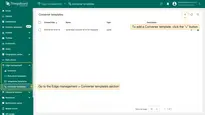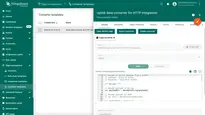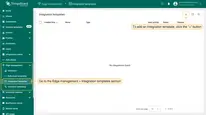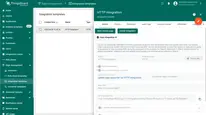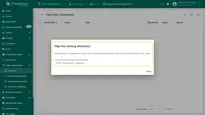- Overview
- Deployment options
- Converter templates
- Integration templates
- Edge limitations
- See Also
- Next steps
| Available since TB Edge version 3.4 |
Overview
Edge Integrations are similar to Platform Integrations. The only major difference is how integrations and converters are configured.
To reuse the same integration across multiple Edges, Integration templates and Converter templates have been introduced.
Integration templates are created in the Cloud, but they are not regular platform integrations and are not launched in the Cloud.
They are assigned to the Edge and launched once they are deployed to the Edge.
At the moment, Integration and Converter templates cannot be modified on the Edge. They are modified in the Cloud, and any changes are automatically propagated from the Cloud to the Edge.
Integration configuration fields (URIs, passwords, etc.) could be replaced by Edge attribute value using placeholders. This way, a single Integration template could be used by multiple Edges, and any specific integration configuration field could be replaced by an Edge attribute value.
Deployment options
ThingsBoard Integration has two deployment options: embedded and remote. See the details and architecture diagrams below.
Embedded integrations
Embedded integration runs in the main ThingsBoard Edge process.
Pros:
- Simplifies deployment of new integration (just a few clicks on the ThingsBoard UI);
- Minimizes latency for message delivery;
Cons:
- Consumes resources allocated to the main ThingsBoard Edge process (network connections, OS threads, and CPU cycles);
- Low level of isolation;
Remote integrations
It is possible to install the remote integration on the local network and to stream the data to the edge over the network.
Let’s assume you have local MQTT broker or OPC-UA server deployed on-premises. Those brokers and/or servers don’t have a dedicated external IP address, so ThingsBoard Edge can’t connect to them directly. However, you can install remote integration close to this edge, in the same local network. This integration will connect to the broker/edge, pull the data and store it in the local file system. Remote integration will stream the data to the ThingsBoard Edge deployed in the network once the network connection is available.
Pros:
- Enables integration with servers deployed on the local network;
- Isolates the integration process from the main ThingsBoard Edge process.
Cons:
- Requires the installation of a separate package;
Learn how to configure integration to run remotely in this guide.
Converter templates
Converter templates can only be created by a tenant administrator. To create a Converter template, log in to the Cloud and go to the Edge management > Converter templates section. These Converter templates are going to be used later in the Integration templates configuration.
Integration templates
Once the Converter template is created, to create an integration template, go to the Edge management > Integration templates section. These Integration templates are going to be assigned to the Edge.
Integration configuration placeholders
In most cases, integration has common configuration part for most of the Edges, except for some specific field(s). To use the same Integration template for multiple Edges while allowing certain values to be unique for each Edge, you can use the placeholders feature. You can add specific attributes to the Edge and then use the name of this attribute in the integration template. This placeholder will be replaced by the attribute value during assignment to the edge.
Let’s look at an example of how HTTP integration could be configured with a unique IP address value per Edge as the Base URL.
- Go to the Edge management > Instances section, click it and select the "Attributes" tab. Add the ipAddress attribute to Edge.
- Go to the Edge management > Instances section, click it and add the ${{ipAddress}} placeholder to the Integration configuration.
- Go back to the Edge management > Instances section and click the Manage Integrations button of the corresponding Edge entity.
- To assign the Integration to the Edge, click the "Assign to edge" button and select it from the drop-down menu. To proceed, click the "Assign" button.
- To confirm that the placeholder is replaced by the attribute value, log in to your ThingsBoard Edge instance, go to the Integration center > Integrations section and click the integration.

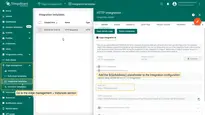
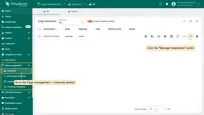
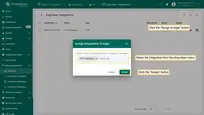
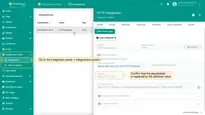
You can assign this integration template to other Edge entities, and each integration on the Edge will have its unique ‘Base URL’ value that’s replaced by the attribute value.
If a particular Edge is missing a placeholder attribute key, the Platform will notify you of this during the Edge mapping or integration configuration update:
Edge limitations
In the current release, Edge is unable to create customers and entity groups. Note that this limitation affects the functionality of the Uplink Data Converter:
- If a non-existent device type is used in the converter, the ‘default’ device type is used.
- if a Customer is not available on the Edge, the device is assigned to the Tenant.
- If the entity group does not exist on the edge, the ‘All’ group gets used.
See Also
Explore guides and video tutorials for specific integrations:
Next steps
-
Getting started guide - Provide quick overview of main ThingsBoard Edge features. Designed to be completed in 15-30 minutes:
-
Installation guides - Learn how to setup ThingsBoard Edge on various available operating systems and connect to ThingsBoard Server.
-
Edge Rule Engine:
-
Rule Chain Templates - Learn how to use ThingsBoard Edge Rule Chain Templates.
-
Provision Rule Chains from cloud to edge - Learn how to provision edge rule chains from cloud to edge.
-
- Security:
- gRPC over SSL/TLS - Learn how to configure gRPC over SSL/TLS for communication between edge and cloud.
-
Features:
-
Edge Status - Learn about Edge Status page on ThingsBoard Edge.
-
Cloud Events - Learn about Cloud Events page on ThingsBoard Edge.
-
-
Use cases:
-
Manage alarms and RPC requests on edge devices - This guide will show how to generate local alarms on the edge and send RPC requests to devices connected to edge:
-
Data filtering and traffic reduce - This guide will show how to send to cloud from edge only filterd amount of device data:
-
- Roadmap - ThingsBoard Edge roadmap.
